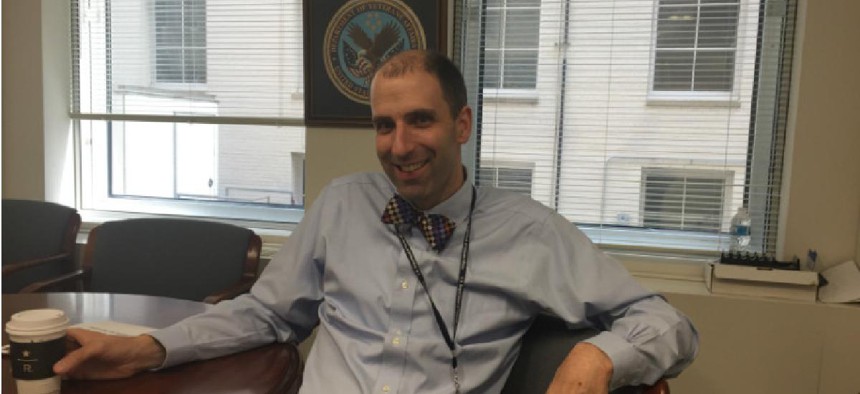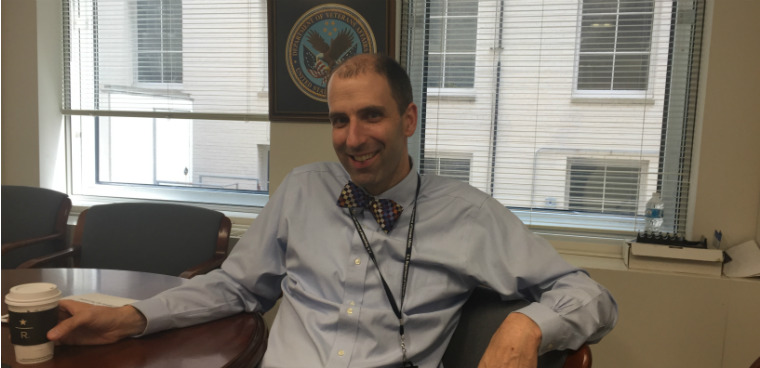VA 'anywhere-to-anywhere' telehealth goes live

The journey to make telehealth routine for patients and practitioners in the VA system is as much about policy as it is about tech.

VA's connected care lead Dr. Neil Evans talks telehealth at agency headquarters. (Photo credit: Adam Mazmanian/FCW)
June 11 marked a major milestone for clinicians delivering telehealth services at the Department of Veterans Affairs. It was the go-live date for a policy shift dubbed "anywhere-to-anywhere," which allows qualified practitioners to log in to VA's telehealth system and see patients without regard to state rules and regulations.
VA has been leading the medical profession in telehealth services for more than a decade, but lately the agency has been looking to regulatory updates rather than technological breakthroughs to advance the delivery of services to its 20 million-strong patient population.
"The most important part of this is that it lets us increasingly -- when it's the right thing to do clinically -- move care closer to patients, deliver care in the home, or in their preferred location," Dr. Neil Evans, who heads the Office of Connected Care at VA, told FCW in an interview at VA headquarters in downtown Washington.
Evans, who sees patients two days a week at the VA's DC medical center, has been with the agency for 17 years and is the point person on telehealth policy and delivery. He helped former VA chief David Shulkin demonstrate telehealth to President Donald Trump at a White House event last year.
The VA delivers telehealth in clinical settings and in the home. In VA clinics, patients and local caregivers and technicians can connect with remote physicians and specialists. This "point-to-point" teleheath allows VA clinics clinic to give patients access to providers across the VA system.
Additionally, the VA Video Connect application that launched last June allows in-home users to connect with doctors, mental health specialists, nurses and even family members and health care proxies to conduct medical visits, follow-up care and psychotherapy. Since launching, VA Video Connect, available to Andorid and desktop users via the VA's website and to iOS users via Apple app stores, has logged 48,000 "ad hoc" patient visits involving 22,700 veterans and 4,500 unique VA providers, Evans told FCW.
VA has implemented "point-to-point" telehealth at 900 sites of care in more than 50 specialties. Evans said that so far, clinical video telehealth has generated a 92 percent satisfaction rate with patients.
The proliferation of telehealth services means that for VA, a video visit with a patient is part of the everyday work of clinicians.
"By 2020 it will be a routine experience that for all of our clinicians -- [that] telehealth is part of the job," the acting head of the Veterans Health Administration Carolyn Clancy told a panel of senators in May. "This is not a unique, boutique activity."
VA's budget for telehealth backs that up. In 2018, the agency has a $1.3 billion telehealth budget, and VA officials are expecting to spend $1.2 billion in 2019 and $955 million on building out and supporting telehealth services and technology.
For Evans, the video chat is just the latest tool clinicians need to do their jobs. Every physician delivering outpatient care uses the telephone to communicate with patients, and telehealth is just the next technology.
"This is going to become health care," Evans said. "It's going to become what we do in health care. We've been targeting, essentially, helping build out the technology infrastructure necessary, so that every primary care provider and every mental health provider can offer a video visit, can integrate that into how they deliver care."
The emphasis on telehealth also allows VA to reduce the stress on its nationwide system, which has more than 30,000 clinical vacancies. Patients in rural settings often bear the brunt of vacancies, and this is true for patients seeking VA care and those looking for care outside the VA system under the new Choice program.
The VA has established 11 tele-hubs for mental health care and nine for primary care around the country, where practitioners can be directed to deliver care to underserved locations for the duration of a clinical vacancy.
"We can start to leverage telehealth, which lets us overcome distances and geography, to connect, to allow the system to run more efficiently where we can match where we have a demand for services but we don't have the supply of providers to meet that," Evans said. "We can now match that demand for services with a supply of providers located elsewhere."
VA's Video Connect app for home use is a simple, streamlined interface, with an intuitive set of commands and buttons that doesn't look much different from video conferencing software such as Skype and FaceTime. The Video Connect app can be used for mental health sessions, but also for quick follow-up visits to check on whether a new medication is effective, or to see how a patient is recovering from a procedure. Providers initiate visits and invite patients and other providers, generating a unique and temporary URL for each visit to ensure that only invitees can attend.
Evans said VA is working on integrating patient data into Video Connect. One enhancement in the works would allow Bluetooth-connected devices to transmit vital signs and data to VA providers in real time. The VA is looking to provide a digital stethoscope to patients, "so that we can actually auscultate heart and lung sounds, run through VA Video Connect," he said.
The recently passed VA Mission Act extends the new regulatory protections to VA telehealth providers. The law now blocks states from imposing sanctions on providers that are recognized by VA as eligible to deliver telemedicine care even if they are out of compliance with state licensing provisions.
The VA also is looking to make technology and connectivity available to veterans where infrastructure is lacking. For patients without home broadband, VA can make available tablets that operate over cellular connections -- including customized models that can support plug-in peripherals that collect and send data from blood pressure monitors as well as Apple iPads that support Video Connect visits.
The department also is looking to shore up delivery of telehealth services via partnership with the Veterans Services Organizations, with a pilot program looking to put telehealth tablets in, for instance, a Veterans of Foreign Wars outpost, so a patient could set up a telehealth visit closer to home rather than travel to a clinic for a point-to-point appointment. VA's also exploring partnership with other agencies including the Post Office as possible telehealth sites.
"There are other potential partners that we can think of where we could essentially create endpoints for veterans to receive care if they couldn't receive it at the home because of a technology barrier," Evans said.



